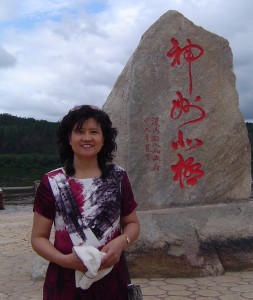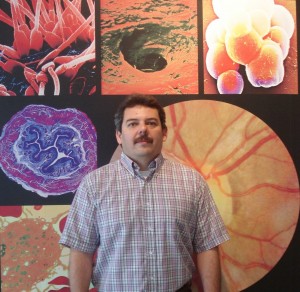This month let’s get acquainted with 4 of the authors whose work is included in the March 2012 issue of NJC. We’ll find out what they have to say about their research and also a little about their taste in music.
 Our first author is Professor Wen-Zhen Wang, who hails from the Chemistry and Chemical Engineering College of Xi’an Shiyou University in Xi’an, P. R. China. Xi’an is in Shaanxi Province in the center of China and is one of China’s oldest cities. It was the eastern terminus of the Silk Road and is also home to the famed Terracotta Army.
Our first author is Professor Wen-Zhen Wang, who hails from the Chemistry and Chemical Engineering College of Xi’an Shiyou University in Xi’an, P. R. China. Xi’an is in Shaanxi Province in the center of China and is one of China’s oldest cities. It was the eastern terminus of the Silk Road and is also home to the famed Terracotta Army.
Wen-Zhen’s research covers the broad areas of coordination chemistry and catalysts. With colleagues from the Republic of China and the Azerbaijan Republic, Wen-Zhen has synthesized a series of pentachromium(II) metal string complexes and studied their structures, magnetic properties and single-molecular electronic conductivity. X-Ray crystallographic studies reported in this NJC article revealed that the structure of the complexes is non-symmetric: the linear metal chain structure consists of two quadruple Cr–Cr bonds and a separated high spin Cr(II) at the end, in a quintet ground state with four unpaired electrons. The complexes are quite resistant to oxidation and one complex exhibited good electronic conductance.
Celine Dion, the popular French-Canadian singer, is Wen-Zhen’s favorite musician. “I like her voice” simply states our chemist, who also loves classical music.
Fine tuning of pentachromium(II) metal string complexes through elaborate design of ligand by Wen-Zhen Wang, Rayyat Huseyn Ismayilov, Gene-Hsiang Lee, Yi-Lin Huang, Chen-Yu Yeh, Ming-Dung Fu, Chun-hsien Chen and Shie-Ming Peng, New J. Chem., 2012, 36, 632-637. DOI: 10.1039/C1NJ20512A
 Dr. Alexander Briceño is an Associate Researcher at the Instituto Venezolano de Investigaciones Científicas (IVIC) in Caracas, Venezuela. His research interests include crystal engineering of photoreactive supramolecular assemblies directed by metal-coordination, hydrogen bonds and ionic interactions; the synthesis and structural characterisation of novel nano/microcomposites based on integrative chemistry of different kinds of materials; hydrogels, carbonaceous materials, MOFs, metal oxides and metal nanoparticles with multiple properties as adsorbents or catalysts.
Dr. Alexander Briceño is an Associate Researcher at the Instituto Venezolano de Investigaciones Científicas (IVIC) in Caracas, Venezuela. His research interests include crystal engineering of photoreactive supramolecular assemblies directed by metal-coordination, hydrogen bonds and ionic interactions; the synthesis and structural characterisation of novel nano/microcomposites based on integrative chemistry of different kinds of materials; hydrogels, carbonaceous materials, MOFs, metal oxides and metal nanoparticles with multiple properties as adsorbents or catalysts.
In their NJC paper, Alexander and his colleagues establish a non-photochemical route to prepare quantitatively, regio- and stereoselectively rtct-pyridyl cyclobutane derivatives using a combination of a solid state [2+2] photoreaction and a controlled isomerisation via a hydrothermal-assisted process. This alternative approach can be very helpful in overcoming the limitations imposed by Schmidt’s topochemical postulate for obtaining regioselective photoproducts with such stereochemical requirements from crystalline assemblies. This method opens a window to develop efficient routes for the preparation of new and conventional cyclobutane-like stereoisomers that are difficult or impossible to access either in solution or by known solid state routes (such as the rcct-configuration). It also includes the possibility of inducing chirality on achiral cyclobutanes.
These rtct cyclobutane derivatives represent novel, attractive, multitopic building blocks for crystal engineering of metal-organic polyhedra, metal-organic frameworks and supramolecular hydrogen-bonded assemblies and are particularly useful for the study of supramolecular isomerism in the solid state.
Alexander’s favorite musician is the Venezuelan José Antonio Abreu, who founded the National System of Youth and Children’s Orchestras and Choirs of Venezuela: “His perseverance and dedication to the development of a classical music education program that uses music as a fascinating tool for the social integration, transformation and personal growth of thousands of youth and children in Venezuela has had influence beyond our frontiers.”
Combining topochemical [2+2] photoreactions and hydrothermal isomerisation for the regioselective and quantitative preparation of rtct-pyridylcyclobutanes by Yennifer Hill, Maholy Linares and Alexander Briceño, New J. Chem., 2012, 36, 554-557. DOI: 10.1039/C2NJ20855E
 Dr Catherine Caris-Veyrat holds a Research Scientist position at the French INRA (National Institute for Agronomical Research). Her laboratory, located in Avignon in southern France, is looking into the safety and quality of plant products.
Dr Catherine Caris-Veyrat holds a Research Scientist position at the French INRA (National Institute for Agronomical Research). Her laboratory, located in Avignon in southern France, is looking into the safety and quality of plant products.
Catherine is interested in micronutrients, mainly carotenoids and their metabolites/oxidation compounds. Speaking of her NJC paper, she says “Our work is mainly in the field of chemistry (synthesis and physico-chemistry) but with an impact in the area of nutrition and health. It could bring insights into the in vivo activity mechanisms of lycopene, a natural bioactive molecule (found in tomatoes), and its possible metabolites.” Since beta-carotene is the main precursor of vitamin A (retinol), researchers think that metabolites of non-provitamin A carotenoids could also be bioactive. “Consumption of tomato or derived tomato products has been shown to be good for health, possibly preventing appearance of degenerative diseases (cancers, cardio-vascular diseases, etc.). The main pigment in tomatoes (the carotenoid lycopene) or its metabolites could be implied in the protective effects. Our work was integrated into a European project on the effect of lycopene on cardio-vascular diseases.”
As a classical music lover, Catherine particularly likes Cecilia Bartoli, an Italian lyric female singer, especially for her interpretation of baroque music, such as that by Handel for example. “Her timbre of voice is very wide and warm and her interpretation of music pieces very expressive” is Catherine’s summary of her favorite musician.
Antioxidant activity of (all-E)-lycopene and synthetic apo-lycopenoids in a chemical model of oxidative stress in the gastro-intestinal tract by Pascale Goupy, Eric Reynaud, Olivier Dangles and Catherine Caris-Veyrat, New J. Chem., 2012, 36, 575-587. DOI: 10.1039/C1NJ20437H
 Our last chemist for this month is Stefan Spange, who is full Professor in the Institute of Chemistry at the University of Technology Chemnitz, Germany. Stefan’s research covers a broad range of subjects: solvatochromism, ionic liquids, hybrid materials, surface functionalization and twin polymerization.
Our last chemist for this month is Stefan Spange, who is full Professor in the Institute of Chemistry at the University of Technology Chemnitz, Germany. Stefan’s research covers a broad range of subjects: solvatochromism, ionic liquids, hybrid materials, surface functionalization and twin polymerization.
His NJC publication reports on four merocyanine-type dyes derived from barbituric and thiobarbituric acid that can be used as probe molecules for the determination of empirical polarity parameters of oxidic, photocatalytic, and even coloured surfaces such as metals. “The appropriate polarity data of these types of surfaces is very important to explain many phenomena such as catalytic activity or polymer-surface interactions and therefore we think that this article is of great importance for a broad audience of chemists.”
While Stefan, like the other featured authors, likes classical music, his favourite kind of music is heavy metal, especially doom- and black metal. “At the moment I listen to Agalloch, My Dying Bride and Helheim from Norway. Also I like to listen to Nocte Obducta and Agrypnie from Germany.” When he was younger, he enjoyed Genesis (with Peter Gabriel), Pink Floyd, Deep Purple, Jimi Hendrix, Black Sabbath and Led Zeppelin.
Probing the surface polarity of inorganic oxides using merocyanine-type dyes derived from barbituric acid by Susan Seifert, Andreas Seifert, Gunther Brunklaus, Katja Hofmann, Tobias Rüffer, Heinrich Lang and Stefan Spange, New J. Chem., 2012, 36, 674-684. DOI: 10.1039/C2NJ20835K
I hoped you enjoyed reading about this selection of chemists. We thank them most warmly for accepting our invitation and having kindly taken their time to answer a few questions for us.
Check back next month for more profiles of NJC authors!










